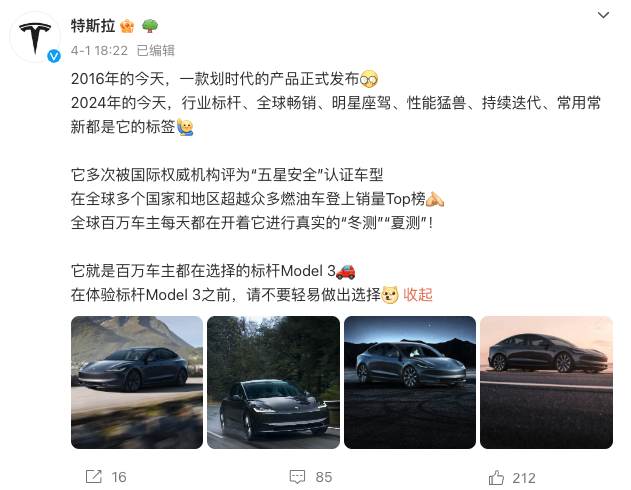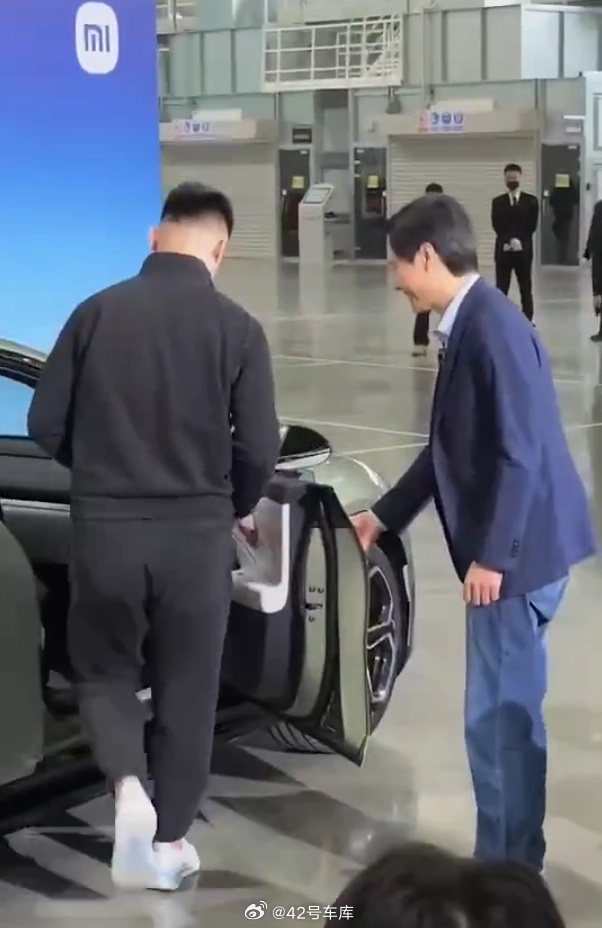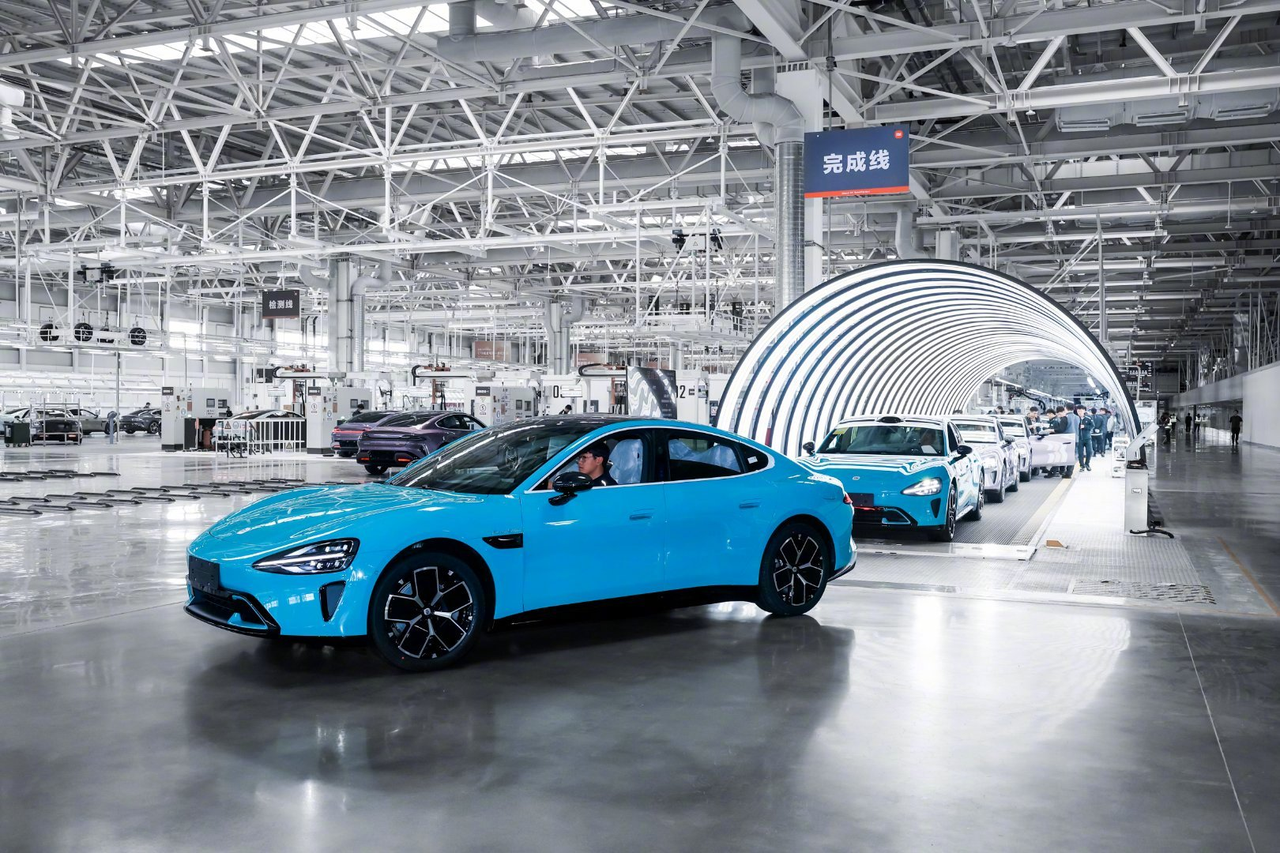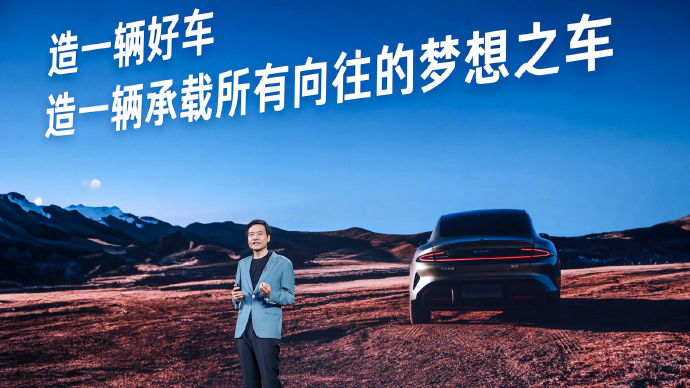Stop viewing Xiaomi through the old lens of a smartphone manufacturer for now, as Xiaomi presently is actually an automobile company.
Many years from now, the first image that comes to people’s minds when they think of Xiaomi may not be associated with smartphones at all, but in fact fully taken over by smart cars. This smart car does not necessarily have to be the recently launched XiaoMi SU7, but this foreseeable future scenario, however, originates from XiaoMi SU7.
At the evening of 28th March, Xiaomi’s tens of billions worth of investment, and a product three years in the making, XiaoMi SU7, formally launched.
On the very night of the launch, the large-scale reservations of XiaoMi SU7 were blooming like mesmerizing fireworks – 10,000 in 4 minutes, 20,000 in 7 minutes, 50,000 in 27 minutes and 88,898 in 24 hours. The sight both exhilarated those held the celebration and astonished those watching. Without a doubt, for Xiaomi, this was a historic event destined to become a hallmark in Xiaomi’s chronicles.
Six days later, as if taking little steps, the historic event happened once again – at 8:08am on 3rd April, Lei Jun announced on Weibo, “from today onwards, Xiaomi officially becomes a car manufacturer”. At the same time, he jokingly encouraged everyone to call him “Factory Manager Lei”.
From the launch of XiaoMi SU7 to Lei Jun’s announcement of Xiaomi formally becoming a car company, a new era of Xiaomi birthed within a span of just six days.
This implies that under Lei Jun’s leadership, the ship that is Xiaomi, after 14 years of journeying through the tumultuous sea, is now heading unwaveringly and irrevocably towards a territory that is far broader yet filled with much steeper waves, more fierce winds and crowded space.
In this vast sea, Xiaomi’s ship is majestic but needs to become even greater.
Six Days That Spanned Longer Than Three Years
How long can six days feel? In the case of Xiaomi car, the six days might feel even longer than the past three years spent on car manufacturing.
The reason is simple. Within the six days after the launch of XiaoMi SU7 and before Lei Jun’s announcement of Xiaomi becoming a car company, there was an array of rumors and unfounded information surrounding Xiaomi car, all sorts of praise and criticism and relentless competition from all fronts.
In short, accompanied by a mixture of good and bad, a flood of attention was drawn to Xiaomi car, pushing it to unprecedented heights but, at the same time, leaving it dizzy and potentially unable to cope. This led to a series of problems arising from the day after the launch of XiaoMi SU7.
Issues Under The Magnifying Glass
On March 29th, a XiaoMi SU7 customer complained that there was no secondary prompt when confirming the order, which led to mistakenly confirming the order and hence unable to refund the deposit. This stirred up some discontent among the users, even prompting the formation of a group seeking justice.
Faced with this unexpected public relations crisis, the official Xiaomi car responded swiftly stating there are in fact three prompts in the XiaoMi car purchase process on the Xiaomi car app and cautioned the users to make wise choices before locking in their configurations.Following serious issue outbursts of XiaoMi SU7 like tyre bursts after collision, seat worn out and tearing, peeling paint even before delivery, and rear wheel screws falling off, the XiaoMi car repeatedly hit the headlines. Despite the response to these issues, XiaoMi car still has a long way to go to recover from the negative effects.
As public opinion crisis kept cropping up, the collective actions from the competitors began again.
On March 30th, SAIC GM took the lead, placarding with coconut tree themed images, mocking messages such as “Sorry, we made a pretty decent SUV within 500,000” and “We neither want to be like Porsche nor Tesla, we just want to be ourselves” that have filled up every corner of sarcasm.
Compared to SAIC GM’s show-off, the new forces went a step further.
On April 1st, the rear-wheel drive enhanced version of ZEEKR 007 was launched at an unchanged price of ¥209,900 but added a tech package worth ¥12,000, wrestling with XiaoMi SU7; NIO introduced a subsidy of up to ¥100 million for fuel vehicle exchange, holding up the shield to its own ET5 and ET5T; Tesla Model 3 offered free starry gray paint originally worth ¥12,000, and Tesla official even remarked on social media, “do not make hasty decisions before experiencing the Model 3 benchmark”, accompanied by a dog emoticon —— the meme’s message was powerful than words.

Interestingly, LUXEED S7 is a strong competitor to XiaoMi SU7, which marks the first direct confrontation between Huawei and Xiaomi in the automotive industry. At the moment, LUXEED S7 is holding its horses. However, according to reports, LUXEED S7 is set to re-launch soon, and it would be intriguing to see what weapon it will pull out to outshine XiaoMi SU7.
Along with the moves of the competitors, spicy commentaries also kept XiaoMi car in the headlines.
For instance, Jia Yueting took turns to both commend and critique XiaoMi on social media, praising the successful launch of the XiaoMi car that demonstrated the growing maturity of China’s new energy vehicle industry chain and the huge advantage of Made-in-China in price-performance ratio. He then changed his tack, casting doubts openly on XiaoMi’s efficiency and marketing skills, and expressing concerns that such copycat culture, shortcut model, and follower mindset might be taken as a model.
Red-shirted AI advocate and 360 Group Chairman, Zhou Hongyi, also shared his thoughts on the XiaoMi car, leaning towards XiaoMi. Zhou Hongyi stated that if XiaoMi car could stand firm, it would undoubtedly be a huge boost to the XiaoMi brand, altering the perception of both XiaoMi and non-Xiaomi users, and possibly turning the tables for XiaoMi mobile phones in the high-end market.Luo Yonghao is perhaps the most optimistic about XiaoMi Cars, his praise for them verging on adoration. Luo said:
XiaoMi is likely to repeat the historical epic of good money driving out bad in the mass consumer car market, following its success in the affordable smartphone market.
In addition, a valuable perspective I gathered from a senior industry consultant within my circle of friends was, “Three years of car production without making a sound, one sound destroys all, it is not XiaoMi’s inability, but rather the industry’s peak imagination for electric vehicles”. Contemplation arises around what potential innovative ideas can be generated within the electric car industry.
The Temperament of a Seasoned Marketer
Six days post the Xiaomi SU7’s launch, the pressure from the public opinion army composed of users, competitors, and industry experts is immense, tightly surrounding the Xiaomi car. This is a torrent of traffic but also a great pressure. As Lei Jun currently posts on Weibo:
Our pressure is really great, everyone is magnifying the problem.
Despite being tightly cornered by public opinion, Xiaomi Cars remains undeterred, sticking to their pace, and striving for the Xiaomi SU7.
Since the Xiaomi SU7’s launch, Lei Jun has consistently updated the Xiaomi SU7 content daily on Weibo, interacting with netizens, kindling goodwill, and timely responding to some major issues, such as how Xiaomi Car was able to produce a vehicle with a high degree of completion like Xiaomi SU7 in just 3 years.
At the Xiaomi SU7’s first batch delivery ceremony on April 3, Lei Jun personally attended and opened the door for car owners, continuing to gather goodwill for Xiaomi Cars.

Xiaomi Car’s official platform also persistently synchronizes with its users, gathering various user queries and providing answers. Currently, “Xiaomi SU7 Answers Netizens” has been updated to its tenth installment; effectively reducing user purchasing doubts.
Dealing with public opinion and mastering marketing are skills honed through the years of trials and tribulations by Xiaomi, the seasoned internet marketing veteran. However, the challenge now is how to convert the current flood of traffic into actual orders, and then transform these orders – with quality, quantity, and satisfaction – into cars in the user’s hands.
Lei Jun Must Continue to Forge Ahead Cautiously
Over the past three years of dedicated car making, Lei Jun said he has been cautious throughout. Now that Xiaomi has genuinely become a car factory, perhaps Lei Jun has to continue cautiously — there are many more long journeys equivalent to three years ahead.
On the one hand, relative to mobile phones, cars have a far greater price; a far longer purchase decision cycle; and far more complex user requirements. This means that not only must Xiaomi Cars execute their product solidly, but they must also invest substantially in time and capital to build brand value, service capability, and manage customer relations. After all, these factors deeply affect user car purchase decisions.
On the other hand, the extent of the current new energy vehicle market’s involution is like a group of heroes who are in desperate circumstances and have to fight for survival, all vying to drink a vat of strong wine together. Outwardly, everyone seems to be daring and willing to drink, ready to drink to the dregs. But in reality, some can continue to toast after drinking three hundred cups, some are drunk after just three cups, and some are already struggling to reach the edge of the bottle.So, transforming from a phone factory to a real car factory, there are still many challenges waiting for XiaoMi Automobile after launching the XiaoMi SU7.
Difficult, but to avoid “mediocrity or decline”
The first key issue is the brand. This is the fundamental connection between XiaoMi Automobile and XiaoMi Mobile, as well as the core bond of mutual empowerment between the two.
Here’s a story I’d like to share with everyone. On March 29, I overheard someone discussing the XiaoMi SU7 on a high-speed train. They essentially viewed XiaoMi as a low-cost brand, and they not only felt that the XiaoMi SU7, priced above 200,000, was still expensive, but they were also skeptical about XiaoMi Automobile’s ability to manufacture a good car on their first attempt.
This represents the viewpoint of some users, and also reveals a major flaw of the XiaoMi brand — it does not possess sufficient high-end value.
During a strategic discussion meeting after the 2022 Spring Festival, XiaoMi explicitly reached a consensus that the “high-end path is the only way for XiaoMi’s growth and the road of life and death for its development”.

Referring to the mobile phone market, Lei Jun (CEO of XiaoMi) posits that “success in the high-end market will attract strong synergetic effects for the whole brand, significantly attracting the demand of users of other brands to switch”. As a technology company, high-end products are a concentrated representation of a tech company’s systematic capabilities. From Lei Jun’s perspective, “if the company cannot continuously improve its capabilities through performance in the high-end market, then in the long term, this company will inevitably be mediocre or even decline”.
In the mobile phone or auto market, the general understanding of ‘high-end’ usually implies a high premium, often derived from a widely accepted symbolic value. This is clearly in conflict with XiaoMi’s pursuit of cost-effectiveness.
However, Lei Jun believes in maintaining cost-effectiveness while also moving toward the high-end market, the core of which lies in the user experience. The efforts to build an ecological cycle of people, cars, and homes is a direct manifestation of this mindset, thus leading XiaoMi’s vision of manufacturing cars as a crucial pathway to enhance its brand value.
Yet, one reality is that the brand value of XiaoMi Automobile currently originates from XiaoMi Mobile. For XiaoMi Automobile to nourish the entire brand value of XiaoMi, there is still a long way to go.
According to Lei Jun’s model of focusing on cost-effectiveness for high-end representation, in the long run, it might either change the auto market’s existing approach toward high-end based on high-premium pricing, or itself be transformed by the same market approach.
A substantial adaptation cost
Another key issue is XiaoMi Automobile’s service capabilities.
Taken as a whole, even though XiaoMi has already accumulated 14 years of experience in dealing with customers, those are mobile phone users. They have zero experience in serving car customers. Moreover, the experience serving mobile phone users is hard to be applied to car customers, as the latter’s purchasing decision-making period is longer, their demands are more complex, and minor carelessness can lead to collective complaints from customers, and even occasional strong protests such as letter writing and banner hoisting.Specifically, XiaoMi Motors has established 59 stores in 29 cities nationwide. However, according to official data, some stores’ daily traffic can reach 10,000 people. As a result, the crowds of customers are the norm, and several days are required to queue for a test drive, greatly diminishing the customer experience and leading to lost orders.
In addition to this, XiaoMi Motors has 29 delivery centers nationwide, with the locked volume for the SU7 model already exceeding 40,000. Furthermore, all the model’s production capacity for this year has been used up, extending the delivery period to 24-27 weeks for SU7, 25-28 weeks for SU7 Pro, and 29-32 weeks for SU7 Max. This extended delivery period has caused more orders to be lost.
Maintenance is another issue. Currently, some of the delivery centers of XiaoMi Motors also function as service centers, which is far from sufficient.
Order loss is regrettable, but it is unavoidable at this early stage of XiaoMi Motors’ development. The good news is that the sales and services infrastructure can be supplemented over time, allowing XiaoMi to fully leverage its organizational efficiency built up over 14 years.
In addition to bolstering the sales and services infrastructure, XiaoMi Motors faces another challenge—vehicle production skill level.
As the delivery volume of the SU7 increases, XiaoMi Motors’ production skills will be seriously put to the test. As Lei Jun says, “everyone is looking at problems under a magnifying glass,” and any minor oversight on the SU7 could call the production skills into question.
When it comes to production skills, users are certainly stricter than XiaoMi Motors’ product managers. Any issues in the production will easily leave a lasting bad impression on the customers.
However, if XiaoMi Motors can maintain steady production, over time the company could also earn impressive reputation mottos like “the car’s still running as people leave, one car passes through three generations”.

After ensuring quality products and services, XiaoMi Motors must continue to relentlessly invest in R&D, advancing OTA updates at an appropriate pace and accelerating the promotion and iteration of intelligent driving to maintain competitive in the waves of smart and electric trends.
Furthermore, XiaoMi Motors needs to continue to maintain or even surpass the standard set by the SU7 to meet customers’ expectations for upcoming products and find a reasonable balance between commercial success and high customer expectations, securing a deeper and more stable foothold in the new energy car market.
In conclusion, in transitioning from a mobile factory to a car factory, XiaoMi has to bear considerable adaptation costs. Some of these costs, such as resetting the attitude towards suppliers and being wary of the inertia formed during the operation of mobile business, cannot be measured in monetary terms.Despite transitioning from a mobile company to an automobile manufacturer, XiaoMi faces numerous challenges. To address these, XiaoMi is effectively driving change from top to bottom, starting with Lei Jun. On the other hand, with its hundred billion cash reserves, the company is poised to transition its financial muscle into tangible combat power.
It is worth mentioning that XiaoMi Automobile is very clear about its starting point for the transformation as Lei Jun once said:
We must soberly realize that stepping into a new field again means facing many challenges. The complexity of the automobile industry, its significant investments, long cycle, and low tolerance for error all call for XiaoMi to approach with trepidation and reverence. Besides, the mainstream players in the industry have at least a six years’ head start on us. As a newcomer, we must remain humble and in awe, striving to catch up in order to succeed.
In Conclusion
XiaoMi is not a young company, but it is a nascent automobile manufacturer.
XiaoMi’s history has provided resources and experience that it can use in vehicle manufacturing, but those same resources and experience could potentially limit it. This is a concern that XiaoMi needs to be particularly cautious of as an automobile manufacturer.
Importantly, XiaoMi’s evolution into an automobile manufacturer is not simply an expansion of XiaoMi’s phone business, but rather a re-sowing and growth process on new ground. As this growth occurs, XiaoMi’s phone business is fostering the growth of XiaoMi automobiles. When XiaoMi Automobile grows into a towering tree, it will protect XiaoMi’s phone business in return.
To further illustrate, at the point in time when XiaoMi announced becoming an automobile manufacturer, XiaoMi may not have brought about disruption in new energy automobile products through XiaoMi SU7, but it continues to enliven the Chinese car market with its substantial influence and early commercial success.
With the official launch of XiaoMi SU7 and XiaoMi’s transformation into an automobile manufacturer, the entry point for new players in this round of China’s new energy vehicle industry revolution is officially closed. What follows will be a thorough elimination round.
This article is a translation by AI of a Chinese report from 42HOW. If you have any questions about it, please email bd@42how.com.
